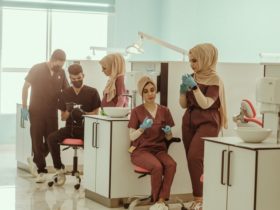From digitizing files, to having artificial intelligence entertain patients, over time, a lot of discoveries and inventions have helped our healthcare system be more of service to others. According to medical professional and Sleep Standards Managing Editor, Chris Norris, innovations have helped resolve most of our healthcare system problems.
Robotic Surgeries and Drone Delivery Systems
Firstly, Norris points out the value of more enhanced robotic surgeries. As of now, doctors are able to perform operations with the help of robots, which allows them to be more flexible, precise, and in control. In hindsight, this technology makes difficult, complicated procedures more manageable and—in some instances—mitigates certain risks.
Another important thing he cited is the use of drone delivery systems. Due to the ongoing global health crisis, a lot of people are still scared to go out of their homes, which makes this idea more and more useful and intriguing. A door-to-door delivery not only makes obtaining prescription drugs easy, it also keeps everyone away from contaminating or passing the virus to others.
Wearable Technologies
From his point of view, Chanh Ho, a Research Physician at the Oxford University Clinical Research Unit and the Head of Medical Review at Constant Delights, says that wearable devices will change some aspects of medicine in the near future. Currently, doctors don’t have a lot of tools to monitor patients’ condition at home, unlike in the hospital where all the fancy and expensive equipment are available. This is where wearable devices step in.
They provide additional data for doctors even when patients sit comfortably at home. These data, including heart rate, blood level of oxygen, blood glucose level, can provide doctors with great insight on how disease is progressing and alert patients to go for a health check sooner.
While the field is advancing at a lightning speed, there are certain concerns. First and foremost, it’s data safety. Data can be easily sent to doctors, but hackers can intercept and steal these data for their own purpose. Secondly, it’s a new field with little regulatory requirement. It’s easy for patients (and customers) to confuse between a medical-grade device (strictly regulated) and a fitness device (relaxed requirement). This can significantly affect the patient monitoring and treatment process.
In conclusion, wearable devices have the potential to make a huge impact on the current way we practice medicine. However, we should be conscious about which device to use and how to interpret the results.
Artificial Intelligence, Natural Language Processing, and Predictive Response Technologies
From a technology perspective, modern-day breakthroughs that will greatly impact the field of medicine include artificial intelligence, natural language processing (NLP), and predictive response technologies. That is, according to Curtis Merriweather, Jr., the CEO of Emergent, Inc. and the Doctor of Management Design and Innovation Fellow at Case Western Reserve University.
Merriweather claims that artificial intelligence technologies may be utilized to increase machine learning of patient medical history. The usage of artificial intelligence can be used to assist doctors in creating actionable information needed to better render diagnosis decisions while minimizing negative cognitive load implications.
Natural language processing technology advancements, on the other hand, may be employed to allow physicians to speak information to the electronic medical records in real time. NLP advances may enable health care professionals to dictate complete and relevant notes into patient-specific electronic health care records. Doctors sometimes complain that notes are incomplete and impede their ability to understand full context.
Lastly, predictive response technologies may be developed to assist with clinical decision support base to deliver optimal patient care decisions. Predictive response capabilities can be utilized to identify patient-specific health detriments to identify and monitor areas of concerns to minimize or prevent negative health implications in the future.
Technology Commercialization partnerships between academia and industry will continue to introduce new technologies into the healthcare domains to continue delivering medical devices, pharmaceuticals, and therapeutics.
Augmented Reality and Virtual Reality
The current modern-day innovation that holds great potential in reshaping the future for medicine is Augmented Reality and Virtual Reality or AR/VR. Based on observation by Dr. Gan Eng Cern, an Ear, Nose, and Throat surgeon, the pandemic highlights its promising potential for training medical students through reconstructing factual-based situations with AR/VR.
Not only will this allow the situation to be reviewed and dissected up until the tiniest part, but it will also allow medical students to experience the whole scenario themselves and see things unfold with their own eyes. This can train them to become even greater decision-makers in the medical field and experience medical practice even remotely.
Additionally, AR/VR is also reinventing the way we analyze and process medical Imaging. MIR and CT imaging are only some of the crucial stages for early detection, diagnosis, and treatment of the most prolific medical conditions. AR/VR, however, is an all-in-one innovation that can easily digitalize the practice of medical imaging, its analysis, and interpretation, all in one go.
Ultimately, Dr. Gan Eng Cern sees it as the revolutionary model that will bring overall healthcare costs down, on a global scale.
Know of any other innovations that will shape the future of medicine? Tell us more in the comments section, and please remember to check back here on Technology in the Arts for more news, views, and opinions in the world of healthcare and tech.











Leave a Reply